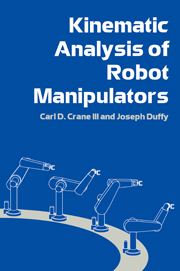Book contents
- Frontmatter
- Contents
- Preface
- 1 Introduction
- 2 Coordinate transformations
- 3 Manipulator kinematics
- 4 Forward kinematic analysis
- 5 Reverse kinematic analysis problem statement
- 6 Spherical closed-loop mechanisms
- 7 Displacement analysis of group 1 spatial mechanisms
- 8 Group 2 spatial mechanisms
- 9 Group 3 spatial mechanisms
- 10 Group 4 spatial mechanisms
- 11 Case studies
- 12 Quaternions
- Appendix
- References
- Index
3 - Manipulator kinematics
Published online by Cambridge University Press: 12 September 2009
- Frontmatter
- Contents
- Preface
- 1 Introduction
- 2 Coordinate transformations
- 3 Manipulator kinematics
- 4 Forward kinematic analysis
- 5 Reverse kinematic analysis problem statement
- 6 Spherical closed-loop mechanisms
- 7 Displacement analysis of group 1 spatial mechanisms
- 8 Group 2 spatial mechanisms
- 9 Group 3 spatial mechanisms
- 10 Group 4 spatial mechanisms
- 11 Case studies
- 12 Quaternions
- Appendix
- References
- Index
Summary
Introduction
The previous chapter introduced point-to-point transformations, that is, the coordinates for a point expressed in some coordinate system were expressed in a second coordinate system. These transformations will now be applied to serial robot manipulators. In this chapter, a spatial link will be defined. Then, different types of joints that can interconnect these spatial links will be discussed. Finally, a standard method of specifying a coordinate system for each link will be introduced together with the transformations that relate these coordinate systems.
Spatial link
In this text, the term “robot manipulator” will be defined as a serial assemblage (or chain) of links and joints. One end is connected to ground, and at the free end is attached an end effector or gripping device. It will be assumed that a link is a rigid body. Figure 3.1 illustrates a link connecting a pair of consecutive joint axes that are in general skew, labeled with unit directional vectors Si and Sj. Two scalar parameters, the link length aij and the twist angle αij, define the relative position of this pair of skew axes. The link length is the mutual perpendicular distance between the axes, and the twist angle is the angle between the vectors Si and Sj. The unit vector aij is defined by Si × Sj = aij sin αij as shown in Figure 3.1.
- Type
- Chapter
- Information
- Kinematic Analysis of Robot Manipulators , pp. 20 - 38Publisher: Cambridge University PressPrint publication year: 1998



